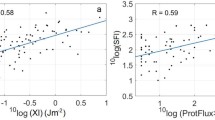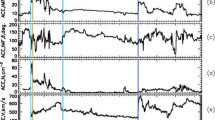Abstract
We investigated correlations between cosmic-ray intensity and 14 solar and interplanetary parameters, which were classified into four cases. We used the modulation of cosmic-ray intensity observed at six distinct stations with different latitudes and cut-off rigidities. We used the partial least-squares (PLS) method to rank the parameters. In the first case, we employed 11 parameters without considering halo-type coronal mass ejections (CMEs) and solar proton events (SPEs). In addition, we considered energetic phenomena associated with halo CMEs for the second case and SPEs in the third case. In the fourth case, we combined all of the parameters. The results based on the magnitude of the first principal component show that the sunspot number (SN), interplanetary magnetic field (IMF), heliospheric current sheet (HCS), and plasma velocity are the parameters with the strongest influence on the modulation of the cosmic-ray intensity at all six stations and in the first case we considered. For a halo-type CME (second case), SN, IMF, HCS, CME speed, and proton density were identified as the most significant parameters, which is identical to the results obtained in the fourth case. During an SPE (third case), the most significant parameters were SN, IMF, HCS, SPEs, and plasma velocity. The INVK and OULU stations, with nearly the same latitude and altitude, exhibit similar results. Our analysis of the results from the low-latitude stations (PSNM and TSMB) yielded different results from the other three stations at higher latitude. For the PSNM and TSMB stations, \(B_{y}\), \(B_{x}\), and the cone angle are the parameters that most strongly influence the modulation of the cosmic-ray intensity. This occurs because the influence of these parameters on cosmic-ray modulation depends on the latitude.















Similar content being viewed by others
References
Ahluwalia, H.S.: 2002, IMF intensity and galactic cosmic ray modulation. Adv. Space Res. 29, 439. DOI.
Ahluwalia, H.S.: 2003, Solar wind modulation of galactic cosmic rays. Geophys. Res. Lett. 30, 1133. DOI.
Ahluwalia, H.S.: 2011, Timelines of cosmic ray intensity, Ap, IMF, and sunspot numbers since 1937. J. Geophys. Res. 116, A12. DOI.
Ahluwalia, H.S.: 2014, Sunspot activity and cosmic ray modulation at 1 a.u. for 1900-2013. Adv. Space Res. 54, 1704. DOI.
Aslam, O.P.M., Badruddin: 2012, Solar modulation of cosmic rays during the declining and mínimum phases of solar cycle 23 comparison with past three solar cycles. Solar Phys. 279, 269. DOI.
Aslam, O.P.M., Badruddin: 2015, Study of cosmic-ray modulation during recent unusual mínimum and mini-maximum of solar cycle 24. Solar Phys. 290, 2333. DOI.
Badruddin, S.M., Singh, Y.P.: 2007, Modulation loops, time lag and relationship between cosmic ray intensity and tilt of the heliospheric current sheet. Astron. Astro. Phys. 466, 697. DOI.
Bertucci, B., Fiandrini, E., Khiali, B., Tomassetti, N.: 2019, Time lag in cosmic-ray modulation and global properties of the solar cycle. Proc. Sci. 358, 1162. DOI.
Butler, B.J., Campbell, D.B., de Pater, I., Gary, D.E.: 2004, Solar system science with SKA. New Astron. Rev. 48, 1511. DOI.
Cane, H.V., Wibberenz, G., Richardson, I.G., von Rosenvinge, T.T.: 1999, Cosmic ray modulation and the solar magnetic field. Geophys. Res. Lett. 26, 565. DOI.
Chibber, R., Subedi, P., Usmanov, A.V., Matthaeus, W.H., Ruffolo, D., Goldstein, M.L., Parashar, T.N.: 2017, Cosmic-ray diffusion coefficients throughout the inner heliosphere from global solar wind simulation. Astrophys. J. Suppl. 230, 21. DOI.
Cliver, E.W., Ling, A.G.: 2001, 22 year patterns in the relationship of sunspot number and tilt angle to cosmic-ray intensity. Astrophys. J. 551, L189. DOI.
Danilova, O.A., Demina, I.M., Ptitsyna, N.G., Tyasto, M.I.: 2019, Mapping of geomagnetic cut-off rigidity of cosmic rays during the main phase of the magnetic storm of November 20, 2003. Geomagn. Aeron. 59, 147. DOI.
Davis, L. Jr.: 1955, Interplanetary magnetic fields and cosmic rays. Phys. Rev. 100, 1440. DOI.
Dorman, L.I.: 2021, Space weather and cosmic ray effects. In: Letcher, T.M. (ed.) Climate Change, Elsevier, Amsterdam, 711. DOI.
Dumbović, M., Vršnak, B., Čalogović, J., Župan, R.: 2011, Cosmic ray modulation by solar wind disturbances. Astron. Astro. Phys. 531, A91. DOI.
Dunai, T.J.: 2010, Cosmic Rays in Cosmogenic Nuclides: Principles, Concepts and Applications in the Earth Surface Sciences, Cambridge University Press, Cambridge UK.
El Borie, M.A., Hamdy, A.: 2018, A correlative study between heliospheric current sheet tilts, cosmic ray intensities and solar activity parameters. Arab J. Nucl. Sci. Appl. 51, 152.
Forbush, S.E.: 1958, Cosmic-ray intensity variations during two solar cycles. J. Geophys. Res. 63, 651. DOI.
Fu, S., Zhang, X., Zhao, L., Li, Y.: 2021, Variations of galactic cosmic rays in the recent solar cycles. Astron. J. Suppl. Ser. 254, 37. DOI.
Grieder, P.K.F.: 2001, Heliospheric phenomena. In: Grieder, P.K.F. (ed.) Cosmic Rays at Earth, Elsevier, Amsterdam, 893. DOI.
Hedgecock, P.C.: 1975, Measurements of IMF in relation to the modulation of cosmic rays. Solar Phys. 42, 497. DOI.
Herdiwijaya, D.: 2019, Distribution of solar energetic particles and magnetic field orientations related to strong geomagnetic storms in solar cycle 24. J. Phys. Conf. Ser. 1204, 012121. DOI.
Huybrighs, V.H.L.F.: 2018, A search for signatures of Europa’s atmosphere and plumes in Galileo charged particle data. DOI.
Inceoglu, F., Knudsen, M.F., Karoff, C., Olsen, J.: 2014, Modeling the relationship between neutron counting rates and Solarspot numbers using the hysteresis effect. Solar Phys. 289, 1387. DOI.
James, M.K., Imber, S.M., Bunce, E.J., Yeoman, T.K., Lockwood, M., Owens, M.J., Slavin, J.A.: 2017, Interplanetary magnetic field properties and variability near Mercury’s orbit. J. Geophys. Res. Space Phys. 122, 7907. DOI.
Kane, R.P.: 2011, Hysteresis of cosmic rays with respect to sunspot numbers during the recent sunspot minimum. Solar Phys. 269, 451. DOI.
Kilpua, E., Koskinen, H.E.J., Pulkkinen, T.I.: 2017, Coronal mass ejection and their sheath regions in interplanetary space. Liv. Rev. Solar Phys. 14, 5. DOI.
Koldobskiy, S.A., Kähkönen, R., Hofer, B., Krivova, N.A., Kovaltsov, G.A., Usoskin, I.G.: 2022, Time lag between cosmic-ray and solar variability: sunspot numbers and open solar magnetic flux. Solar Phys. 297, 38. DOI.
Kuznetsov, S.N., Yushkov, B.Y., Denisov, Y.I., Kudela, K., Myagkova, I.N.: 2007, Dynamics of the boundary of the penetration of solar energetic particles to Earth’s magnetosphere according to CORONAS-F data. Solar Syst. Res. 41, 348. DOI.
Mangeard, P.S., Clem, J., Evenson, P., Pyle, R., Mitthumsiri, W., Ruffolo, D., Sàiz, A., Nutaro, T.: 2018, Distinct pattern of solar modulation of galactic cosmic rays above a high geomagnetic cuttoff rigidity. Astrophys. J. 858, 43. DOI.
Mavromichalaki, H., Paschalis, P., Gerontidou, M., Papailiou, M.C., Paouris, E., Tezari, A., Lingri, D., Livada, M., Stassinakis, A.N., Crosby, N., Dierckxsens, M.: 2022, The updated version of the A.Ne.Mo.S. GLE alert system: the case of the Ground-Level Enhancement GLE73 on 28 October 2021. Universe 8, 378. DOI.
Miroshnichenko, L.I.: 2014, Solar Cosmic Rays: Fundamental and Applications, 2nd edn. Springer, Heidelberg.
Morrison, P.: 1956, Solar origin of cosmic-ray time variations. Phys. Rev. 101, 1397. DOI.
Nymmik, R.A., Panasyuk, M.I., Petrukhin, V.V., Yushkov, B.Y.: 2009, A method of calculation of vertical cutoff rigidity in the geomagnetic field. Cosm. Res. 47, 191. DOI.
Panasyuk, M.I., Kalegaev, V., Miroshnichenko, M., Kuznetsov, N.V., Nymmik, R., Popova, H., Yushkov, B., Benghin, B.: 2018, Near-Earth radiation environment for extreme solar and geomagnetic conditions. In: Buzulukova, N. (ed.) Extreme Events in Geospace, Elsevier, Amsterdam, 349. DOI.
Ross, E., Chaplin, W.J.: 2019, The behaviour of galactic cosmic-ray intensity during solar activity cycle 24. Solar Phys. 294, 8. DOI.
Strauss, R.D., Potgieter, M.S., Büsching, I., Kopp, A.: 2012, Modelling heliospheric current sheet drift in stochastic cosmic ray transport models. Astrophys. Space Sci. 339, 223. DOI.
Syed Ibrahim, M., Shanmugaraju, A., Moon, Y.J., Vrsnak, B., Umapathy, S.: 2018, Properties and relationship between solar eruptive flares and coronal mass ejections during rising phase of solar cycles 23 and 24. Adv. Space Res. 61, 540. DOI.
Synder, C.W., Neugebauer, M., Rao, U.R.: 1963, The solar wind velocity and its correlation with cosmic-ray variations and with solar and geomagnetic activity. J. Geophys. Res. 68, 6361. DOI.
Tezari, A., Paschalis, P., Gerontidou, M., Mavromichalaki, H., Karaiskos, P.: 2019, Radiation exposure of aircrews due to space radiation. Hellenic Nucl. Phys. Soc. Adv. Nucl. Phys. 26, 210. DOI.
Thomas, S.R., Owens, M.J., Lockwood, M., Scott, C.J.: 2014, Galactic cosmic ray modulation near the heliospheric current sheet. Solar Phys. 289, 2653. DOI.
Tjus, J.B., Desiati, P., Döpper, N., Fichtner, H., Kleimann, J., Kroll, M., Tenholt, F.: 2020, Cosmic-ray propagation around the sun: investigating the influence of the solar magnetic field on the cosmic-ray sun shadow. Astron. Astro. Phys. 633, A83. DOI.
Usoskin, I.G., Kananen, H., Mursula, K., Tanskanen, P., Kovaltsov, G.A.: 1998, Correlative study of solar activity and cosmic ray intensity. J. Geophys. Res. 103, 9567. DOI.
Van Allen, J.A.: 2000, On the modulation of galactic cosmic ray intensity during solar activity cycles 19, 20, 21, 22, and early 23. Geophys. Res. Lett. 27, 2453. DOI.
Wold, H.: 1996, Estimation of principal components and related models by iterative least squares. In: Krishnaiaah, P.R. (ed.) Multivariate Analysis, Academic Press, New York, 391.
Wold, S., Sjöström, M., Eriksson, L.: 2001, PLS-regression: a basic tool of chemometrics. Chemom. Intell. Lab. Syst. 58, 109. DOI.
Zhang, J.N., Luo, A.L., Zhao, Y.H.: 2009, Automated estimation of stellar fundamental parameters from low resolution spectra: the PLS method. Res. Astron. Astrophys. 9, 712. DOI.
Acknowledgments
A.N.I. Putri would like to thank the Organization and Governance of the Indonesia Endowment Funds for Education (LPDP) for supporting this research by a doctoral education scholarship.
Author information
Authors and Affiliations
Contributions
D. Herdiwijaya wrote the concept and design of the research; A.N.I. Putri wrote the draf manuscript text; A.N.I. Putri and D. Herdiwijaya revised the main manuscript; All authors contributed to data analysis and interpretation. All authors reviewed the manuscript and results. All authors gave final approval of the version to be published.
Corresponding author
Ethics declarations
Competing interests
The authors declare no competing interests.
Additional information
Publisher’s Note
Springer Nature remains neutral with regard to jurisdictional claims in published maps and institutional affiliations.
Rights and permissions
Springer Nature or its licensor (e.g. a society or other partner) holds exclusive rights to this article under a publishing agreement with the author(s) or other rightsholder(s); author self-archiving of the accepted manuscript version of this article is solely governed by the terms of such publishing agreement and applicable law.
About this article
Cite this article
Putri, A.N.I., Herdiwijaya, D. & Hidayat, T. On the Correlation of Cosmic-Ray Intensity with Solar Activity and Interplanetary Parameters. Sol Phys 299, 12 (2024). https://doi.org/10.1007/s11207-023-02249-9
Received:
Accepted:
Published:
DOI: https://doi.org/10.1007/s11207-023-02249-9




